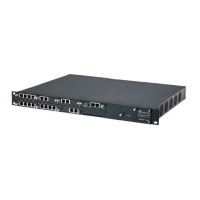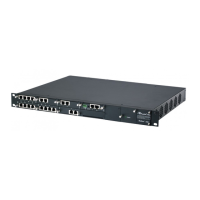Version 7.2 365 Mediant 1000B Gateway & E-SBC
User's Manual 17. Control Network
Parameter Description
The Proxy Set associated with the Server-type IP Group must be
configured with multiple IP addresses (or an FQDN that resolves
into multiple IP addresses).
This feature is also applicable to IP Group Sets (see Configuring IP
Group Sets on page 719). If a user is bound to a registrar
associated with this Server-type IP Group which also belongs to an
IP Group Set, IP Group Set logic of choosing an IP Group is
ignored and instead, the device always routes requests from this
user to this specific registrar.
A user's "stickiness" to a specific registrar ends upon the following
scenarios:
If you modify the Proxy Set.
If the Proxy Set is configured with an FQDN and a DNS
resolution refresh removes the IP address to which the user is
bound.
User registration expires or the user initiates an unregister
request.
The Proxy Set's Hot-Swap feature (for proxy redundancy) is not
supported for users that are already bound to a registrar. However,
you can achieve proxy "hot-swap" for failed initial (non-bounded)
REGISTER requests. If a failure response is received for the initial
REGISTER request and the response’s code appears in the
Alternative Routing Reasons table (see Configuring SIP Response
Codes for Alternative Routing Reasons onn page 713), "hot-swap"
to the other IP addresses of the Proxy Set is done until a success
response is received from one of the addresses. In the case of
failed REGISTER refresh requests from users that are already
bound to a registrar, no "hot-swap" occurs for that request; only for
subsequent refresh requests.
When using the User Info table (see SBC User Information for SBC
User Database on page 809
), registrar "stickiness" is supported
only when the user initiates the REGISTER request. Therefore, you
must configure the 'Registration Mode' parameter of the IP Group
(User-type) to which the user belongs, to User Initiates
.
Authentication Mode
authentication-mode
[IPGroup_AuthenticationMod
e]
Defines the authentication mode.
[0] User Authenticates = (Default) The device does not handle the
authentication, but simply forwards the authentication messages
between the SIP user agents.
[1] SBC as Client = The device authenticates as a client. It receives
the 401/407 response from the proxy requesting for authentication.
The device sends the proxy the authorization credentials (i.e.,
username and password) according to one of the following:
1)Account configured in the Accounts table (only if authenticating
Server-type IP Group), 2) global username and password
parameters (only if authenticating Server-type IP Group), 3) User
Information file, or 4) sends request to users requesting credentials
(only if authenticating User-type IP Group). For more information
on Accounts, see Configuring Registration Accounts on page
383.
[2] SBC as Server = The device acts as an Authentication server:
Authenticates SIP clients,
using the usernames and passwords
in the User Information table (see SBC User Information for
SBC User Database on page 809). This is applicable only to

